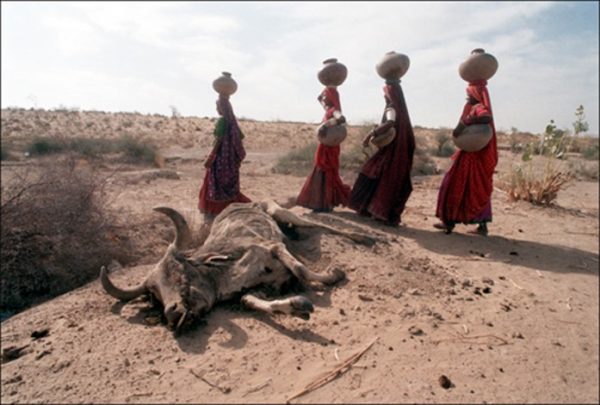
Disease, Malnutrition, War, Famine — The Cost of Drought
In the media and news industry there is an old adage, “If it bleeds, it leads.” That means the stories that will get the most interest and attention from the public will be headlines about murder, mayhem, war and disaster. Unfortunately, this is true.
Alas, when it comes to drought, the headlines will read like an apocalyptic movie poster. The human and environmental cost of drought is massive and global. Disease, malnutrition, war, famine, lack of sanitation, the list goes on when it comes to the impact. Drought affects the lives of over two billion people. The World Resources Institute lists 44 countries as having high baseline water stress link.
Drought helped cause food riots and economic collapse in Morocco; displaced 1.3 million people in Syria; swelled the ranks of armed rebels in Mali and two million people in Libya were cut off from their water supply by an armed group. Last month, the BBC reported on “How water shortages are brewing wars” link. The cost is staggering.

Drought Cost
Five Times More Likely to Move
The World Health Organization completed a study in 2016 that compared the effects of increased dry conditions to increased rains. The chart below shows the impact of both. However, the World Bank recently reported that people are five times more likely to move following drought conditions as they are after floods or periods of excess water link. Indeed, the Food and Agriculture Organization of the United Nations reported that for all hazards (including storms, flood, earthquake, volcanic eruptions, tsunamis) between 2006 and 2016, drought was two to three times more destructive to crops and livestock than any other disaster link. As you can see the cost of drought is stacking up.

Good News for Drought-Related Costs
In spite of all the doom and gloom, there is some good news. Improved water management strategies, such as wastewater treatment, drip irrigation, and inexpensive high tech monitoring systems can shore up supplies and reduce waste. This can have a major impact on existing water availability.
The other water game-changer is the improvement in water locating technologies. The combination of Geographic Information Systems and advanced instrumentation has, for the first time, enabled the identification of Deep Seated Water to help solve the world’s water shortage. Deep Seated Water is high-quality groundwater, typically sourced from deeper aquifers that are located below shallow aquifers link.
The U.S. National Groundwater Association estimates that there are 22,600,000 cubic kilometers of groundwater in the upper two kilometers of the earth’s crust. Each cubic kilometer is about 264 billion gallons. The world uses just 3,717 cubic kilometers of water per year. So, we have enough water in the ground to supply Earth for over 6,000 years at today’s global consumption rates. Tapping even just a fraction of this largely untapped vast resource can supplement our current water supplies in a sustainable fashion. The illustration below shows where Deep Seated Water is located.

Vast amounts of fresh water are located in deeper aquifers
Deep Seated Water can be accessed economically through underground geologic pathways and channels. Finding them is like finding the proverbial “needle in a haystack.” But with today’s technology, it can be done with near 100% certainty.
The point is, the cost of drought is enormous. It is a global challenge. However, it can be virtually eliminated by using available technology and having the courage to employ it. At AquaterreX, we’re doing everything we can to help.